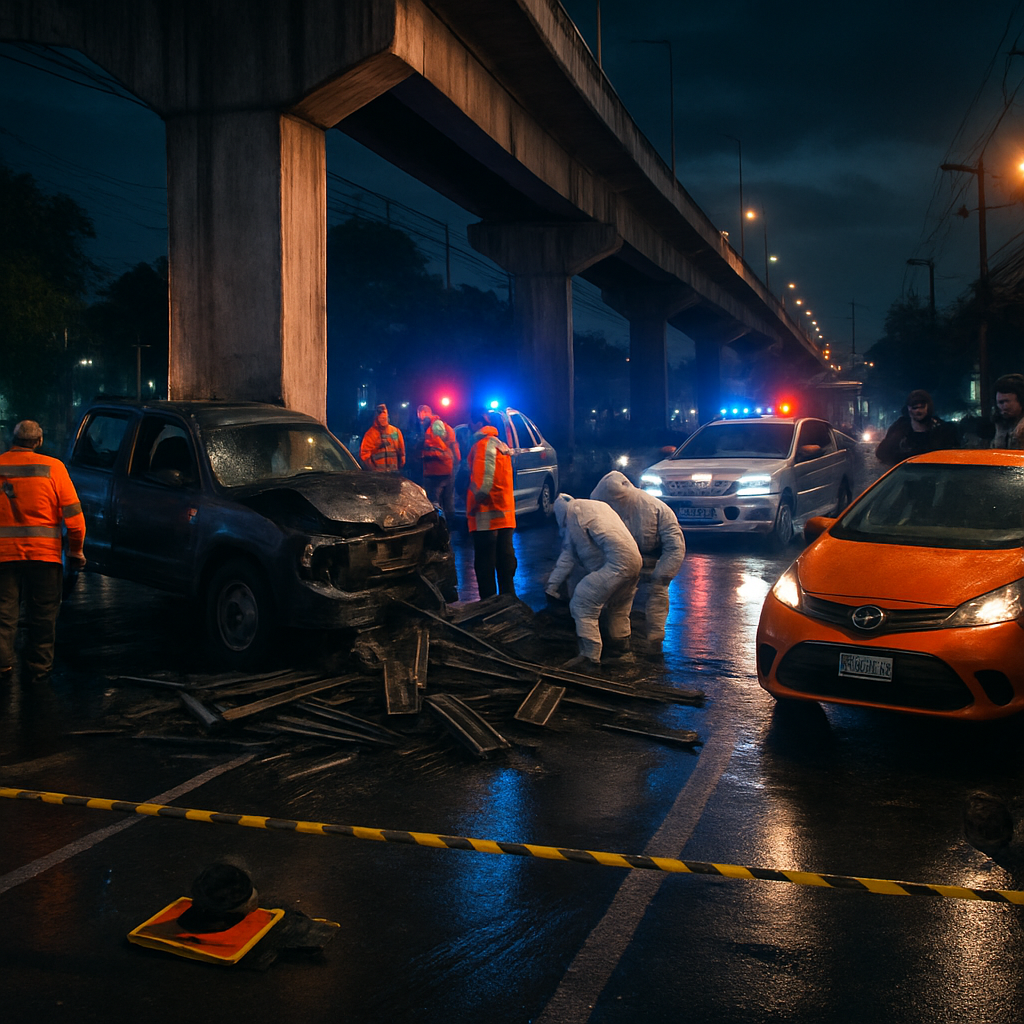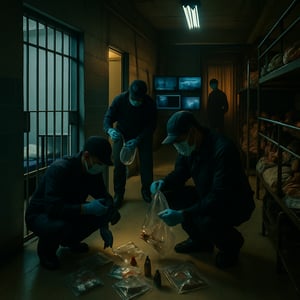In the quiet hours before dawn on November 24, a routine shift turned tragic on Phahonyothin Road in Pathum Thani. At around 12:30 a.m., a 52-year-old security guard named Kamphon was struck and killed while attempting to cross the outbound express lane in Khlong Nueng subdistrict, Khlong Luang district — not for himself, but to help others. What began as a traffic incident escalated into a fatal chain of events that left the community stunned and investigators piecing together the final, harrowing moments.
Emergency crews from the Ruamkatanyu Foundation, officers from Khlong Luang Police Station and a forensic team from Thammasat University Hospital arrived at the scene to find Kamphon’s body in the far right lane. The impact had thrown him some distance from the point of collision, underlining the force involved. Nearby, about 50 metres away, an orange Honda Jazz with Bangkok plates sat parked in the left lane. Its windshield was smashed, its front end bearing the ugly signs of a sudden, violent stop.
The driver of the Honda, 32-year-old Satthawat, remained at the scene and waited for police. He told investigators he was traveling from Bangkok to Saraburi when, in the blink of an eye, he failed to see Kamphon crossing the express lane and could not stop in time. One minute a man was rushing to help a crash victim; the next, he’d been struck by a passing car. Satthawat has been taken to Khlong Luang Police Station for further questioning as the inquiry continues.
At the heart of the incident was a separate crash: a Toyota pickup truck, registered in Bangkok and heavily laden with steel formwork, had apparently lost control and slammed into a support pillar of a pedestrian overpass. The pickup’s driver, 35-year-old Nopparat, told police he had been transporting building materials from Nakhon Ratchasima when he lost control and struck the column. That damaged pickup — the original wreck that drew bystanders — was the reason Kamphon ran into harm’s way.
A motorcycle taxi driver at the scene provided a poignant detail that has already circulated through local news outlets: Kamphon, who worked as a security guard nearby, saw the pickup crash and dashed across the express lane to offer aid to the truck driver. His instinct to help cost him his life. The scene investigators now have to reconstruct includes a rescue attempt turned tragic, a heavily loaded truck, a smashed Honda Jazz and a resonant reminder of how dangerous express lanes can be after dark.
Police have carefully documented the area and sent Kamphon’s body to Thammasat University Hospital for a post-mortem examination. Forensic teams and traffic investigators will examine skid marks, vehicle damage, sightlines, and spacing to determine what combination of speed, visibility and timing led to the fatal collision. Witness statements — including Satthawat’s and Nopparat’s — will be weighed alongside the physical evidence to form a clearer picture of responsibility and causation.
Local residents and commuters along Phahonyothin Road were shaken. The express lane is a road many motorists use every day, but late-night conditions, heavy loads in construction vehicles and the presence of pedestrians near crash scenes make it especially hazardous. This incident is a stark example of the split-second dangers pedestrians and drivers face on busy arteries at night.
While the investigation continues, the community has been left with several sobering reminders: the peril of crossing high-speed lanes, the unpredictable behavior of overloaded vehicles, and the bravery — and risk — of bystanders who rush to help. Authorities and safety advocates often urge people to call emergency services rather than run toward an accident on expressways; here, the compassionate instinct to assist ended in tragedy.
Satthawat remains in police custody for questioning as officials attempt to determine whether charges will be filed. Nopparat’s statement about losing control of his fully loaded pickup will be examined alongside vehicle inspections and any available CCTV footage. For Kamphon’s family, coworkers and neighbors, factual answers cannot erase the emotional toll of losing a man who stepped forward to help.
As investigators work through the evidence and the post-mortem results, authorities are expected to release updates. For now, the scene on Phahonyothin Road is a solemn reminder that accidents ripple far beyond the metal and glass involved: they change lives, sometimes forever. If there’s a takeaway from this heartbreaking night in Khlong Luang, it is both practical and humane — keep emergency numbers at hand, prioritize safety when helping at road incidents, and remember that even the best intentions can have tragic consequences on high-speed roads.
Local officials, rescue teams and police continue their duty to uncover what happened and to prevent similar tragedies. The community waits for answers, and for a measure of closure for Kamphon’s loved ones — a brave man who lost his life trying to do the right thing.


















What a tragic story — Kamphon was a real hero for running to help. It feels wrong that doing the right thing can get you killed on a highway. Drivers and authorities need to make crash scenes safer at night.
I agree he was brave, but people keep saying ‘just call emergency services’ like it’s always possible in the moment. Human instinct is to help, not stand by and dial.
True, instinct drives you, but maybe training or public campaigns could teach safer ways to help, like using hazard lights and waiting for official responders.
Campaigns are fine but fix the infrastructure first — express lanes with poor lighting and overloaded trucks are the real problem here.
Yes, making lanes safer and enforcing load limits would reduce these tragedies, so it’s not just about telling people not to act heroically.
Sometimes the law punishes people who help; other times it praises them. We need consistent protections for bystanders who try to save lives.
Exactly, a Good Samaritan law with public awareness could save lives and reduce hesitation to assist safely.
Why was anyone crossing an express lane at midnight? That’s reckless. He should be remembered, but people must learn situational awareness.
That’s a cold take; he wasn’t crossing for himself, he was helping someone in dire need. Sometimes you risk yourself to save another and that’s noble.
I respect the intention, but we have to balance nobility with common sense. Reckless actions on high-speed roads endanger others too.
This argument always pits compassion against safety. We need structural changes so compassion doesn’t mean suicidally running into traffic.
Overloaded pickup trucks are everywhere and they’re ticking time bombs on the highway. If Nopparat lost control maybe someone should be checking load enforcement and licensing.
Authorities will check vehicle load and driver statements, but enforcement gaps are common. Evidence and CCTV will be key to assigning responsibility.
Exactly — we need cameras and spot checks, not just post-accident finger pointing.
I hope they press charges if negligence is found, both for the pickup driver and for reckless driving by the Honda. Someone has to be accountable.
My heart breaks for the family. He was trying to do good and now they’re shattered. How do we honor people like Kamphon without glorifying risky behavior?
Communities can set up memorials and push for safer road design. Also offer support funds for families of bystanders who die helping others.
A fund would help and might incentivize local businesses to contribute. Practical gestures give families breathing room to grieve.
From a forensic viewpoint, the timeline, skid marks and point of impact will tell whether any driver could have reasonably avoided him. Emotional responses are important, but evidence matters for policy.
Investigators will examine braking distances, sightlines, light levels and vehicle weights to reconstruct events scientifically. It’s irresponsible to speculate before the post-mortem and scene survey are complete. Still, overcrowded loads and dark express lanes are frequent contributing factors.
Can forensic teams release preliminary findings to calm rumors? People are already assigning blame on social media.
They can, but carefully — premature conclusions can hamper the legal process. Accurate, measured updates are better than sensational speculation.
The evidence you describe can determine culpability and criminal charges, but public pressure sometimes pushes prosecutors to act before facts are clear.
This is why we need stricter penalties for drivers who don’t adapt to road conditions. If Satthawat ‘didn’t see’ the man, that’s not an excuse. Drivers owe a duty of care, especially at night.
Night driving is hard and glancing away for a second can be fatal. But penalties alone won’t fix infrastructure or driver training.
Penalties are part of the mix — combined with training and enforcement, they can deter dangerous driving.
I drive that road every day and the lighting there is awful. Trucks are often overloaded and weave at night. The system is failing both drivers and pedestrians.
He was brave. I would be scared to run into a fast road though. Everyone should learn to call for help instead.
Calling is good, but immediate help can save lives — we just need safer protocols for bystanders.
If immediate help is needed, use reflective clothing or signals first. Blind runs across an express lane are likely to end badly.
Local councils should install barrier screening near pillars and better signage to prevent vehicles from hitting infrastructure in the first place.
CCTV will tell the story, but in many places footage disappears or is ‘inconclusive’ when it implicates someone. I wouldn’t be surprised if nothing meaningful comes out publicly.
Don’t be cynical — modern forensics and media scrutiny usually force transparency now. Let the investigators do their job.
Maybe in some places, but the pattern of cover-ups exists. Citizens should demand independent oversight on footage release.
Whether footage is released or not, honoring the victim and supporting his family is immediate work the community can do.
This is such a sad reminder to keep emergency numbers on speed-dial. Emotions aside, planning and awareness prevent more deaths.
If the pickup driver admits losing control because of a heavy load, there should be criminal recklessness charges if improper loading caused this. Road safety laws exist for a reason.
One more thing: commercial transport regulations are often skirted because of costs. If enforcement becomes stricter, businesses complain, but innocent people stop dying.
Enforcement needs resources and political will. Without both, systemic violations continue unchecked.
Exactly — and that’s where citizens need to press officials and support budgets for road safety enforcement.
Is there any update on family support or compensation for Kamphon’s relatives? The article didn’t say. Governments should have emergency payouts for tragedies like this.
I hope local NGOs step in quickly. Memorial funds and community drives can help while official processes take time.
I’ll check local pages and donate if a fund appears. Small acts can mean a lot.
Procedurally, Satthawat’s statement will be compared against physical evidence; ‘I didn’t see him’ is defensible only if the victim was effectively invisible to a reasonable driver. That’s what investigators will determine.
Right — visibility factors like glare, street lights, and headlight angles are quantifiable and will be analyzed. It’s a technical, not just moral, question.
But don’t let technicalities excuse negligence. If a reasonable driver could have avoided him, charges should follow.
Why are pedestrians even allowed near express lanes at night? There should be strict barriers preventing anyone from entering except emergency responders.
Barriers help, but accidents still happen when vehicles go off course. It’s a complex engineering and policy issue.
Complex, yes — but ignoring it keeps killing people. Start with simple measures like cones and emergency lane closures.
This makes me scared to help someone because I might die. Maybe we should have volunteers who are trained to go on highways.
Volunteer responder teams are a good idea; training and reflective gear would reduce risk significantly.
That would make me feel safer if I wanted to help.
Sad story and complicated. I hope justice is fair and not just loud opinions online. For now, be careful out there.
Local planning must prioritize pedestrian safety near busy roads. A little foresight saves lives and prevents these grim headlines.
Agreed — urban planners often react after tragedies, but proactive design stops them before they happen.
Exactly; invest in prevention rather than lamenting after the fact.
If the community pushes for CCTV transparency and better lighting, change can happen. Civic pressure works when sustained.
Sustained civic pressure needs organized leadership, not just noise on social media. Find local champions and keep up the effort.
Good point — volunteers, NGOs and local councillors need to coordinate for real change.